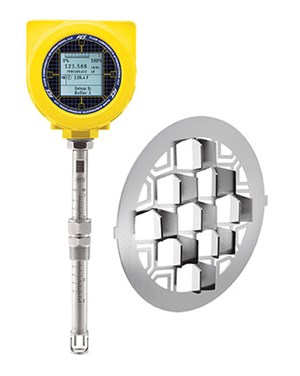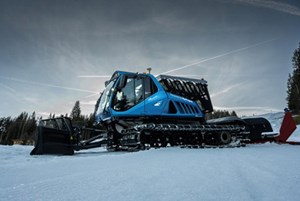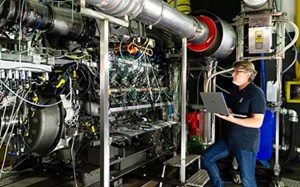Articles
H2Tech: Technology Spotlight
T. CAMPBELL, Managing Editor
H2 PRODUCTION
New solar panel achieves 9% efficiency in converting water into H2 and oxygen
A new kind of solar panel, developed at the University of Michigan, has achieved 9% efficiency in converting water into H2 and oxygen—mimicking a crucial step in natural photosynthesis. It represents a major leap in technology, nearly 10 times more efficient than solar water-splitting experiments.
The biggest benefit is driving down the cost of sustainable H2. This is enabled by shrinking the semiconductor, typically the most expensive part of the device. The team’s self-healing semiconductor withstands concentrated light equivalent to 160 of our galaxy’s sun.
Most H2 is produced from methane, using a great deal of fossil energy in the process. However, plants harvest H2 atoms from water using sunlight. As the world focuses on reducing carbon emissions, H2 is attractive as a standalone fuel and a component of sustainable fuels made with recycled CO2. Likewise, it is needed for many chemical processes, such as fertilizers production.
The outstanding result comes from two advances: the ability to concentrate the sunlight without destroying the semiconductor that harnesses the light; and using both the higher energy part of the solar spectrum to split water and the lower part of the spectrum to provide heat that encourages the reaction. This is enabled by a semiconductor catalyst that improves itself with use, resisting the degradation that such catalysts usually experience when they harness sunlight to drive chemical reactions.
In addition to handling high light intensities, it can thrive in high temperatures that are punishing to computer semiconductors. Higher temperatures speed up the water-splitting process, and the extra heat encourages the H2 and oxygen to remain separate rather than renewing their bonds and forming water.
For the outdoor experiment, a lens about the size of a house window was set up to focus sunlight onto an experimental panel just a few inches across. Within that panel, the semiconductor catalyst was covered in a layer of water, bubbling with the H2 and oxygen gasses it separated.
The catalyst is made of indium gallium nitride nanostructures placed on a silicon surface. That semiconductor wafer captures the light, converting it into free electrons and holes—positively charged gaps are left behind when the light liberates electrons. The nanostructures are peppered with nanoscale balls of metal, 1/2,000th of a millimeter across, that use those electrons and holes to help direct the reaction.
An insulating layer atop the panel keeps the temperature at 75°C (167°F), warm enough to help encourage the reaction while also being cool enough for the semiconductor catalyst to perform well. The outdoor version of the experiment, with less reliable sunlight and temperature, achieved 6.1% efficiency at turning the energy from the sun into H2 fuel. However, indoors, the system achieved 9% efficiency. The next challenges the team intends to tackle are to improve the efficiency further and to attain ultra-high purity H2 that can be directly fed into fuel cells.
Azolla Hydrogen commissions AZ225 Biodrome onsite H2 production unit
Azolla Hydrogen has successfully commissioned the AZ225 Biodrome unit, which is now fully operational. The unit has undergone rigorous testing and performed exceedingly well. Azolla’s Biodrome technology produces fuel cell spec H2 onsite, ready for dispensing to customers.
The AZ225 unit will produce 225 kg/d of H2 utilizing a modest footprint of 424 ft2. The unit combines Azolla Hydrogen’s Biodrome technology with a 400-bar Neuman & Esser compressor, creating a seamless and efficient system.
Hydrogen Optimized elevates the performance of its RuggedCell water electrolyzers
Hydrogen Optimized, a Key DH Technologies Inc. subsidiary, has achieved high-performance benchmarks for its patented RuggedCell™ water electrolyzers in a simulation of variable power conditions found at the 30-GW AMAN green H2 project in Mauritania.
The project is led by CWP Global, a renewable energy developer building large-scale green H2 projects around the globe. Green H2 is expected to supply 15% of the world’s energy needs by 2050 in a net-zero scenario. To deliver the first shipments of green H2 and its derivatives within this decade, CWP Global is building projects in prime locations rich in renewable energy and partnering with industry leaders to ensure the right technology is implemented. CWP Global recently signed a memorandum of understanding (MoU) with Hydrogen Optimized to explore the integration of 500 MW−750 MW RuggedCell™ green H2 plants with the company’s wind and solar portfolio.
The simulation at Hydrogen Optimized’s high-power demonstration facility in Owen Sound, Ontario, Canada, replicated wide swings in the electrical power input to RuggedCell™ electrolyzers that correspond with the Mauritania project’s actual wind profile. A key finding is that RuggedCell™ technology maximizes the production of consistently pure H2 gas by efficiently utilizing the available intermittent energy from renewable sources such as wind and solar across a wide range of electrical power inputs. Previous experiments have demonstrated that the RuggedCell™ responds dynamically to variations in electrical current levels from 0% to 100% power load in seconds.
This capability is vital to the economic viability of large-scale green H2 plants powered by intermittent renewable energy. CWP’s projects are typically located in remote locations served by island grids not connected to public electrical grids, which are typically more stable.
The simulation demonstrated that the RuggedCell™ operates efficiently over the full dynamic range of power produced by real-world intermittent renewable energy conditions, produces stable H2 gas purity over the entire dynamic range and maintains excellent thermal stability during operation for optimal energy efficiency.
Another significant advantage of the RuggedCell™ is its design simplicity, making it durable and reliable—an advantage particularly in challenging environmental conditions such as those found in remote deserts. For example, the RuggedCell™ does not require gas-liquid circulation pumps, contrasting with most water electrolysis systems. As a result, there are no parasitic power loads that would otherwise diminish the system efficiency and reduce H2 production.
H2 APPLICATIONS INNOVATIONS
GSE Solutions to develop H2 plant model for NuScale Power
GSE Solutions will build a H2 plant model for NuScale Power’s VOYGRTM small modular reactor (SMR) plant simulator. GSE will provide the models, integration and testing support to NuScale using its JProTM Dynamic Simulation Software.
GSE is one of a handful of companies tapped to support NuScale in developing and assessing an economically optimized integrated energy system (IES) for H2 production using electricity and process heat from the VOYGRTM SMR. The existing NuScale control room simulator will be modified to evaluate the dynamics of the IES and will include GSE’s models for H2 production. The project will determine the technical and economic feasibility of connecting a H2 production facility to a NuScale SMR and evaluate operating parameters.
H2 STORAGE AND TRANSPORTATION APPLICATIONS
Vopak and Hydrogenious LOHC Technologies collaborate to improve H2 logistics
Vopak and Hydrogenious LOHC Technologies will incorporate a joint venture, LOHC Logistix, for H2 storage, transport and supply based on Hydrogenious’ liquid organic H2 carrier (LOHC) technology. This is one of the major steps both companies have agreed on to push LOHC market solutions and large-scale pilot projects forward.
The company uses the thermal oil benzyl toluene, already well-established in the industry as a heat transfer medium and featuring ideal properties for safe handling in ports, as a liquid organic H2 carrier (LOHC-BT). Due to its characteristics as a flame retardant and non-explosive carrier with a high volumetric energy density, benzyl toluene can be handled like a fossil liquid fuel within existing infrastructure, tankers and vehicles at ambient pressure and temperature, making it a natural fit with port infrastructure and fleet of vessels, railcars and tank trucks. After H2 (dehydrogenation) release, the LOHC can be reused to bind H2 hundreds of times.
The joint venture LOHC Logistix GmbH located in Germany will support both parties to facilitate their efforts to supply green H2 to offtakers using LOHC-based transportation (e.g., ship, train, tanker). The incorporation of the joint venture is subject to customary closing conditions. It will purchase hydrogenation and dehydrogenation services from the respective LOHC plant operating companies and organize transport for transportation and supply.
H2 EQUIPMENT
NewHydrogen launches its green H2 generator prototype
NewHydrogen has provided an update about its H2 generator prototype's launch, showcasing its novel low-cost and high-performance catalyst technology. The prototype will continue as a platform for incorporating additional next-generation electrolyzer component innovations.
In preparation for the cell performance evaluation, a systematic acidic water splitting test is underway, using commercial platinum and iridium-based catalysts to establish commercial catalysts' benchmark performance and set up a standard testing protocol.
More catalysts with consistent material characteristics are needed to operate the prototype electrolyzer platform fully. Therefore, the company is amplifying the synthesis of its noble catalysts before the performance evaluation that includes activity transition into an electrolytic cell, long-term stability, H2 production rate, specific energy consumption and estimated overall costs of new catalysts.
Thermal flowmeter with Vortab insertion panel flow conditioner supports green fuel cell energy
The ST80 Thermal Mass Flow Meter with a Vortab insertion panel (VIP) Flow Conditioner from Fluid Components International measures gas flow accuracy to provide clean electric power while reducing or eliminating harmful emissions such as carbon, nitrous and sulfur oxide that damage the environment.
These advanced thermal mass flowmeters coupled with tab-type flow conditioners are helping process and plant engineers support green fuel cell energy initiatives that produce electricity, H2 and water. The ST80 Flow Meter and VIP Flow Conditioner are installed to monitor multiple fuel cell process applications, such as fuel gas primary feed, pressure relief, deoxidizer relief line flow, cooling tower vent, anode exhaust gas and fresh air blower discharge flow. VIP flow conditioners are utilized upstream from the meters where less-than-ideal pipe straight-run conditions could impact overall measurement accuracy.
FPT Industrial releases the XC13 H2 combustion engine
FPT Industrial and PRINOTH has released the PRINOTH LEITWOLF h2MOTION, H2-powered snow groomer with an internal combustion engine. The new concept vehicle is equipped with the new FPT XC13 H2 version, 13 liter, six-cylinder engine, delivering 460 hp (338 kW) and 2,000 Nm of torque.
Fully ready for field tests, the LEITWOLF h2MOTION can be the ideal solution for sustainability-oriented ski resorts, such as Snow Space Salzburg Bergbahnen, where remaining CO2 emissions are largely attributable to slope grooming.
Unveiled at IAA 2022, the new FPT XC13 is a multi-fuel single-base engine. From diesel to natural gas—including biomethane—to H2 and renewable fuels, the base engine has been designed with multiple versions to offer maximum component standardization and easy integration into the final product.
The H2 combustion engine installed on the PRINOTH LEITWOLF h2MOTION is an additional technology in the FPT Industrial portfolio for zero CO2 emissions solutions, offering customers the familiarity they are accustomed to with traditional machines. The H2 fuel is stored in five tanks mounted on the back of the machine for an indicative running time of more than 3 hr.
Rolls-Royce successfully tests mtu engines with pure H2
Rolls-Royce has successfully tested its 12-cylinder gas variant of the mtu Series 4000 L64 engine, running on 100% H2 fuel. The tests, carried out by the Power Systems business unit, showed great characteristics in terms of efficiency, performance, emissions and combustion. These tests mark an important step towards the commercial introduction of H2 solutions to meet customers’ demand for more sustainable energy.
The first installation of mtu engines running on 100% H2 is already planned for the enerPort II lighthouse project in the German inland port of Duisburg as part of developing a climate-neutral energy supply for a new container terminal.
In times of low demand and high renewable energy generation—from wind or solar, for example—the excess energy can be channeled through an electrolyzer to convert water to H2, which can later be used as fuel in any number of applications.
For several months, the mtu gas engine has undergone bench testing and continuous improvement in efficiency, performance, emissions and combustion using 100% H2 as fuel. With green H2, these mtu engines can be operated in a CO2-neutral manner. For gas engines already installed, Rolls-Royce offers a conversion solution.
Due to the different combustion behavior of H2 compared to natural gas, some engine components, including fuel injection, turbocharging, piston design and control, were modified in the test engine. However, by using proven technologies within the Power Systems’ portfolio, such as mtu turbochargers, injection valves, and engine electronics and control, the development of the engine to use H2 was advanced quickly and efficiently.





